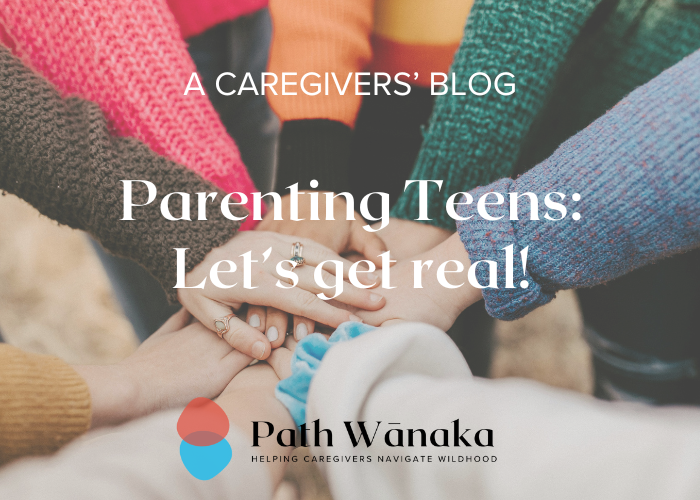When the Lights Dim: A Parent's First Steps into Teen Mental Health (Caregivers' blog)
Path Wānaka
16 May 2025, 8:00 PM

I want to start this post by saying: I never expected to be here, writing this. Three years ago, our 14-year-old son—once a happy, popular, cheeky boy—began to change. At first, we chalked it up to adolescence. Mood swings, withdrawal, sleeping late, the usual teenage angst, right?
We missed it completely!
We had no experience with clinical depression. No one tells you what to look for until it’s already dark. One day we were a typical family, and the next, we were learning how to keep our son alive. That’s not an exaggeration, and if you’re here reading this, you might know exactly what I mean.
This post is the first chapter of our story—a raw, honest look at the very beginning of our journey. This isn’t a guidebook, and it won’t be perfect. Your story will be different from ours. But everything I’m about to share comes from a place of deep, hard-earned love. We made mistakes. You probably will too. But that’s okay. When you’re fumbling in the dark, sometimes you just need one thing to land—one thing to stick—and you go from there.
Here’s what helped us (and what didn’t) in those early days. Think of it as a list to start with, not a checklist to complete.
1. Talk to Your GP – And Come Prepared
Book the appointment. I know it feels huge, but your GP can be a gateway to essential support.
Tip: Go in with notes. Write down what you’ve noticed: mood changes, sleep patterns, withdrawal, any mentions of self-harm or hopelessness. Sometimes teens don’t have the language for their distress—and sometimes they’re scared you’ll panic—so you may need to be their voice.
Explain what you're hoping to get from the appointment:
- Access to therapy or medication if appropriate
- Support navigating school pressures and assessments
- A way to explain to your teen what’s happening and begin to contextualize it
Then, ask the GP if your child might feel more comfortable speaking without you in the room. Let your teen know you’re open to hearing anything, but that their honesty is the priority—and that they are allowed privacy.
2. Build a Support Network
Tell the school. Even if your teen doesn’t want you to. We spoke with our son's headmaster, mental health support workers, and teachers. This meant he didn’t have to perform when he couldn’t. No “How was your weekend?” small talk. No pressure to meet deadlines while barely getting out of bed. His school counsellor (a legend in our eyes) used to say, “Just go home if this isn’t the place for you today.” That gave our son the power to listen to his own mental state, and act on it with permission.
3. Therapy is Like Shopping for Jeans
Finding a therapist that fits is hard. Not because your teen is resistant (though they might be) but because the right person is hard to find. Be upfront with them: not every therapist will click, and that’s okay. Just like jeans, it might take trying a few before you find the right pair.
Start by asking your GP for a list of local therapists specialising in youth and the areas your child is struggling with (anxiety, depression, trauma, etc.). Then contact all of them—yes, all! Follow up! Chase it!
4. Know About Child and Family Services
If things escalate, your GP can refer you to Child and Family Services. It sounds scary, and yes—it can be grim—but these people know what they’re doing. They’re trained to assess risk and offer real help. Sometimes just the act of calling them makes your teen feel like they’re back in control, like someone else is holding the weight with them.
Even if you don’t need them now, tuck this into your back pocket. Knowing they’re there can be comforting.
5. Consider a Psychiatrist
Yes, the wait was long, but the one we saw was brilliant. He looked at the whole picture—not just meds, but mood tracking, habits, CBT techniques. Our son hated him (because he held him accountable), but in hindsight, it was exactly what he needed.
A good psychiatrist will make space for your teen to take ownership of their mental health. That’s part of the long game.
Counselling & Mental Health Services - Central Otago
Path Wānaka - more information on our website
6. Use a “Number System” to Communicate
This was life-changing. Ask your teen to rate how they feel on a scale from 1 to 10, where 7 is their “normal.” Anything below 3 is worth noticing. A 2 or 1 means immediate action—maybe even a trip to ED or a 111 call. This helps them articulate their state without needing to explain it all.
It also stops every check-in from feeling like an interrogation. A simple “What’s your number?” lets you keep tabs without overwhelming them.
7. Phones and Sleep – Boundaries Save Lives
This was a battle. We took our son’s devices at 10 p.m., and let me tell you—it caused rage. But we explained that his room needed to be a haven, a place where the world wasn’t allowed in, even for a few hours.
We let him have music but removed access to the chaos of the internet at night. It wasn’t a punishment; it was a reset. We told him: if you feel unsafe or overwhelmed at night, wake us. That was the rule. No scrolling into darkness alone.
Final Thoughts – You're in the First Chapter
If you’re reading this, you’re likely where we were: at the beginning. It’s terrifying. You’re scrambling to learn a new language while your world spins off its axis. But you’ve taken the first step—and that matters.
This post is just the start. There’s more to come—about the long nights, the therapy wins and losses, the school meetings, and how we slowly, painfully, found our way back to something like hope.
We didn’t do everything right. But we loved him, fiercely. And that’s what carried us.
Your journey will look different. But you’re not alone.
More soon.
With love and solidarity,
A parent who’s been there.
Parent | Whānau Support Group – Free Group Coaching for Parents.
Contact us: [email protected]


